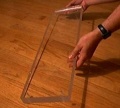Hydraulic press
From PyroGuide
|
A hydraulic press is a very useful tool used to press rocket motors, delay elements, flares, ground spinners, buzz bombs, fountains, smoke devices and more. It is made from a automotive type hydraulic jack, adjustable metal plates and blast plate. The firework device is placed between the two plates and the composition is pressed with a large amount of pressure turning the powdery composition into a solid mass. A press is also used for compositions that cannot be rammed due to its sensitivity to shock/friction for example whistle rocket mix. |
[edit] ConstructionThese first pictures show some of the major component parts of the press. This is one of two pieces of 4 inch wide channel. They are 16 inches long and are used at the top and bottom of the press. They are useful for mounting eye bolts and the blast shield as well as providing a space in the base for the large pressure bearing nuts. I chose to drill the two holes where the 3/4 inch threaded rod goes through. The task of drilling holes in a piece of channel is not nearly as daunting as drilling through 3/4 inch flat bar as shown below. |
|
This picture shows one of three pieces of 4 inch wide flat bar. They are 3/4 inches thick and 14.5 inches long. A notch has been cut in each end to accommodate a 3/4 inch threaded rod. As you can see, the cutting is very rough because it was done with a simple cutting torch by the metal dealer. These three pieces cost me $15 and the torch cutting cost another $5. You very well might do better if you try to find this material from a scrap dealer. |
|
This is the six ton hydraulic piston jack. I purchased it from an auto parts store for about $20. The force of this jack is sufficient to bend the pieces of channel. This is why I needed to use the pieces of flat bar to reinforce the channel pieces at the top and bottom. |
|
This is a piece of 1.25 inch thick plexiglass that I used for the blast shield. I was very fortunate to receive this free from Donald Haarman who apparently salvaged it from a dumpster. Thanks again, Donald!! Part of the fun of these projects is the "scrounge" phase. Whatever is used for the blast shield, it's very important to include it. I certainly feel a whole lot safer with 1.25 inches of plexiglass between the press and my face. |
|
This close-up view of the top shows the channel placed on top of the flat bar. The threaded rods hold them both in place with a nut and washer on each side. The blast shield is bolted to the channel through a wood offset block. This gives me a little more working room around the middle pressing deck. |
|
The base of the press is assembled identically to the top. The retraction springs are attached to eye bolts which are mounted through the base channel. |
|
This picture shows the attachment of the blast shield to the base channel. You can also see the bolt which secures the base of the hydraulic jack to the base of the press frame. |
|
This view from the opposite side of the blast shield illustrates the attachment and placement of the retraction springs. The springs add stability to the middle pressing deck and conveniently retract it when the release valve of the jack is opened. These springs are fairly expensive at $2.85 apiece, but are well worth the contributions they make to the design. |
|
Finally, the finished product is shown. This press design was partially inspired by a similar plan sold by Firefox Enterprises. The major difference is that the Firefox design places the hydraulic jack on top of the pressing deck and the object to be pressed is placed on the base of the pressing frame. This way, the pressing surface comes down from above, whereas the design shown here causes the pressing surface to push up. |
[edit] References
- Dan Williams, Amateur Pyrotechnician - http://fogoforum.us/index.html










